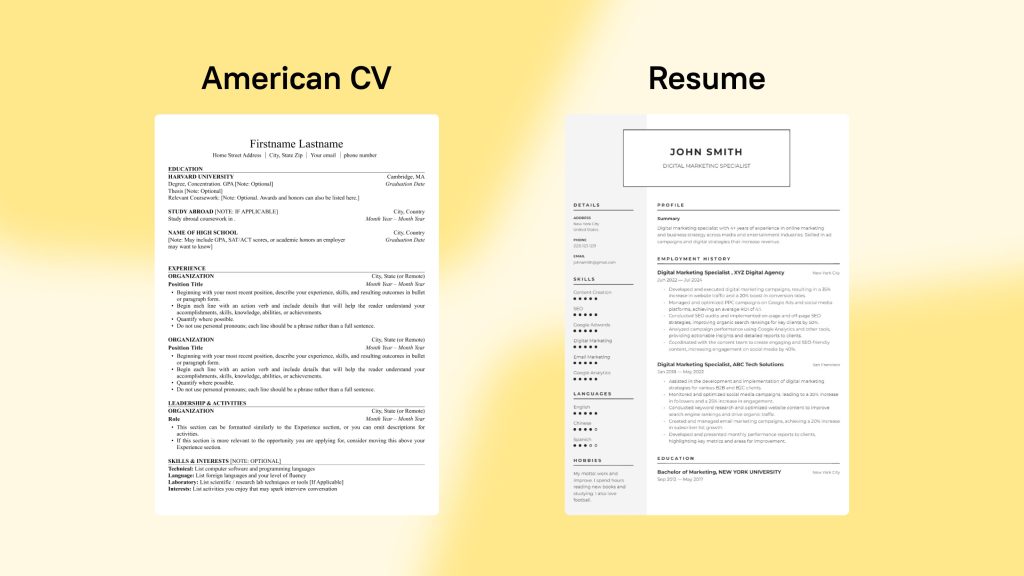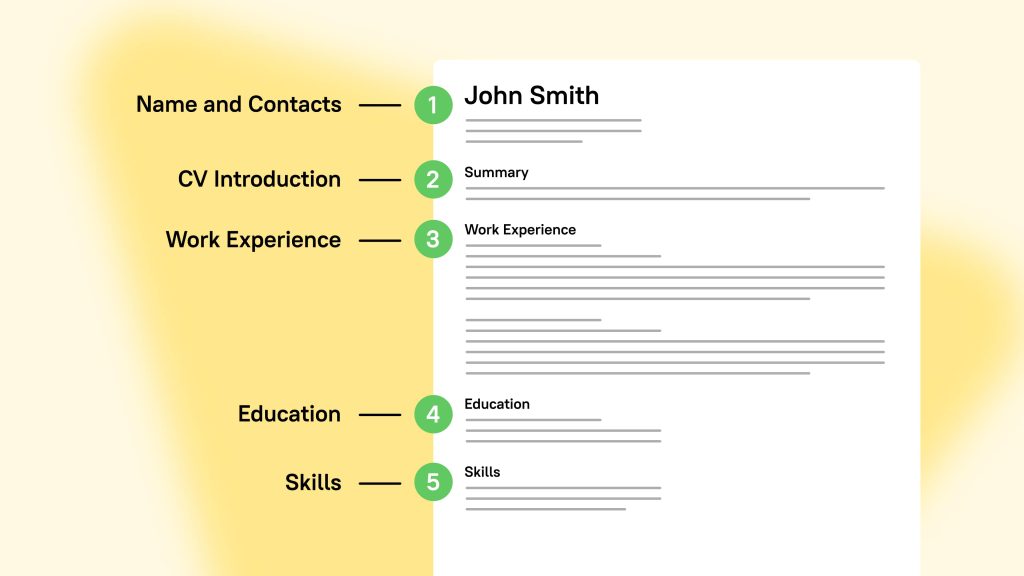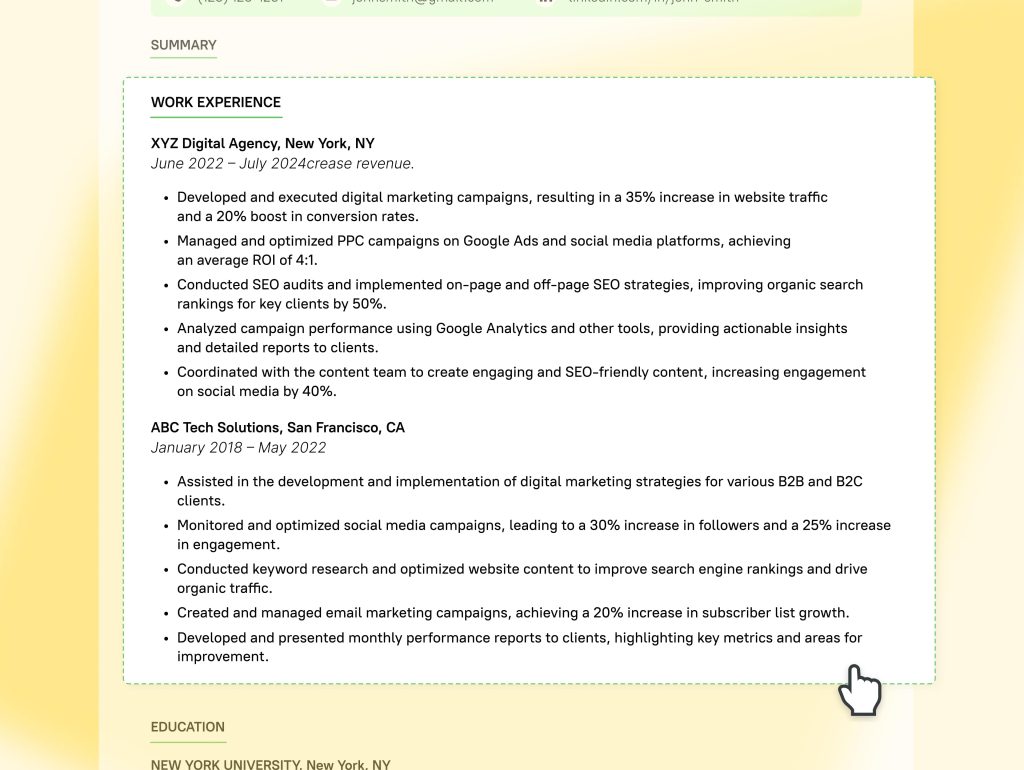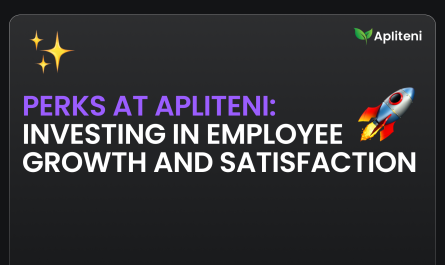Job searching is a process we all have gone through. Monitoring available positions, sending out CVs, and anxiously waiting for replies — the job-hunting struggle is real, and we know that.
That’s why we’re here to assist you on your journey to finding the perfect job by helping you create a standout CV. Our colleagues from the People Ops department have kindly shared their opinions on the matter. With over 8 years of experience in HR, they have provided their insights and tips for making your CV shine.
What is a CV?
CV stands for curriculum vitae, which translates from Latin as “course of life.” This describes the essence of a CV — it’s a detailed outline of your professional life, from education to the most recent job position.
CV vs. Resume
However, to understand what a CV actually is, we need to talk about resumes and meaning differences around the world:
- In Europe, Asia, Australia, and even parts of Canada, a CV is identical to a resume, and the two words are used interchangeably. It’s usually a 1-2 page description of your relevant skills and job experiences.
- In the USA, CVs are much longer and usually required for academic jobs. They describe your expertise in detail, including every title, publication, project, achievement, diploma, and certificate. It’s usually 2+ pages long and very formal with no design elements.

Simply put, if you’re applying for a job in the USA, you should use an American resume. In the rest of the world, you need to send a resume when asked for a CV.
In our article, we’ll focus on a CV for regular jobs. If you’re applying for a job in Europe or live there, all the tips in this article will be useful for you too.
How to Write a CV?
There are dozens of CV templates online, each with different visuals and formats. However, the key to a good CV lies not in its beauty, but in its structure.
As Apliteni specialists have noted, “Sometimes it’s difficult to navigate a person’s CV if it doesn’t have a clear and logical structure. You might simply get lost in the text.”
Remember, your CV should be reader-friendly. A well-structured document is much stronger than a beautiful one. For that, you can follow the 5-step structure:
- Contact information
- CV introduction
- Work experience
- Education
- Skills

Let’s go through each step in detail.
Contact Information

First and foremost, the employer needs to know who you are and how to contact you if they find your experience relevant. Write down:
- Your first and last name
- Number
- Link to LinkedIn or messengers (optional)
All that information should be visible. Make your name in large font and add bullet points to the contact information. For example, you can add “✉️” next to the email or “?” next to your number, making them easier to see.
Remember, if you have just started job hunting after a long break, ensure your contact information is up-to-date.
CV Introduction

After you introduce yourself, it’s time to show your professional background. In CVs, this is done in the “Introduction,” a.k.a. the “About me” or “Summary” section.
Here, you provide a quick overview of your expertise. To write this part, ask yourself the following questions:
- How many years of experience do you have?
- In what niches have you worked before?
- What are your strongest skills?
- What tool do you work with? Programming languages? Systems?
If you’re applying for a creative job, like copywriting or design, this is a good place to share a link to your portfolio. The same goes for recommendations from previous employers.
- Apliteni Experts’ Tip
Adapt your introduction to the position you’re applying for. For example, check what skills are required and highlight your proficiency in them. This immediately shows that you’re suitable for the role — but be honest and include skills you actually have.
Most importantly, match the tone of your summary to the language used in the job vacancy. If it’s formal, make your summary more formal.
Work Experience

This part is the most important, so you should focus and make it as strong as possible.
For that, our colleagues recommended using the XYZ formula: “Accomplished [X] as measured by [Y], by doing [Z].”
For example, instead of saying, “Improved customer satisfaction scores,” try, “Increased customer satisfaction scores by 25% within six months by implementing a new feedback system and training staff on customer service best practices.“
Key Apliteni tips:
- Focus on achievements: Highlight your accomplishments with specific, quantifiable results.
- Use numbers: Aim for 80% of your bullet points to include metrics and detailed descriptions of your contributions.
- Be honest: Don’t come up with random numbers to look good. If you don’t have statistics, just write down what you did and what tool you used.
- Don’t add too much: Consider adding about 4-5 most important points to each job position you had. You can list less important ones during the interview.
Relevant experience only: If somewhere in the past you’ve had irrelevant experience, like working in a fast food chain at 18, don’t add this to your CV.
Education

A clear education section is important in your CV, especially for recent graduates or those with minimal work experience. In this case, detail the education section to highlight all of your educational accomplishments.
However, if you’re an expert with years of experience, keep your education section brief and focus on your work.
At a minimum, your education section should include:
- University/College name
- Location: country, city, state
- Date of graduation
- Degree(s)
Additionally, you can include relevant courses you’ve attended or your GPA if it’s above 3.5.
Skills

You might think the skills section is one of the least important parts of a CV because it doesn’t prove your qualifications directly. However, well-chosen skills can show employers that you understand the job requirements.
Apliteni tip: Look at the vacancy you’re applying for. See which skills they list and adapt this section to them, but remember to be honest. Also, include skills that you can prove with examples. Especially when it comes to soft skills, it’s important that all listed skills were used in previous jobs.
There are two primary types of skills: hard and soft. Let’s look at some you might include in your CV:
| Hard Skills | Soft Skills |
| Graphic design | Teamwork |
| UI/UX design | Decision making |
| Javascript/CSS/Python | Critical thinking |
| Data analysis | Conflict management |
| Digital marketing | Creativity |
| Data science | Organizational skills |
Additional Information

Sometimes, 5 main sections aren’t enough for the job position, so you should consider listing additional information. This includes:
- Languages: Candidates with multiple languages are valuable in various industries.
- Interests: List hobbies relevant to the job position. For creative jobs, include links to your blogs or works so the employer can see your creativity.
- Volunteer work: This can show that you’re involved in the community and capable of teamwork.
- Publications: If you’re a recent graduate, you can include publications from your college days.
How to Address Gaps in Your CV?
Life is unexpected, and sometimes some circumstances prevent us from working, like maternity leave or burnout. These situations create gaps in your CV, which many fear may ruin their chances of getting a job.
We’ve asked Apliteni experts for their advice on how to handle gaps and whether we should fear them:
“When addressing a gap in your resume, it’s important to handle it honestly and strategically.
Don’t say: “From May 2023 to December 2023, I was looking for a job.”
Say: I worked in Job 1 from 05/2020 to 05/2023 and in Job 2 from 12/2023 to 12/2024 — no focus on the gap.
This approach keeps your CV current and relevant, helping you find a position where you’ll feel comfortable. Here is what you can do, depending on the gap reason:
- Break for Rest: Simply list the job start and end dates. If asked about the break during an interview, briefly explain it was a rest time without personal details.
- Long Job Search: Similarly, list the start and end dates accurately. Avoid manipulating dates to cover the gap. This can create doubts and lessen your chances of getting a job when the truth comes out.
- Irrelevant Experience: If you have an experience that’s not directly related but you want to include it, summarize it with a brief paragraph. For example, “2016-2018 Retail: Before moving to web development, I worked as a cashier while studying.”
- Maternity Leave: Despite common misconceptions, it’s perfectly fine to disclose that you had a maternity leave. HR specialists understand that it’s normal.
Moreover, you can demonstrate that you have been studying during your maternity leave or break. Relevant courses during gap dates show your dedication to work and development.”
CV Tips from Apliteni People Ops Experts

We understand that job searching can be stressful, but it’s a part of our professional journey. To help you gain confidence, our experts shared their top tips to create a standout CV for your dream job.
Make a CV Yourself
While AI is becoming popular for CV writing, it often produces vague and generic job descriptions, consisting of many “empty” phrases. Most importantly, it’s clear when a CV is AI-generated.
Writing a CV yourself demonstrates that you care and understand what is important for the job.
Be Honest
Lying about your skills and experience might seem like a shortcut to landing a job, but it often backfires. Eventually, employers will discover that you’re not the right fit or you might find yourself in a role that doesn’t suit you.
Honesty ensures that you and your employer are on the same page from the start. If you understand that the job isn’t for you, it doesn’t mean you’re unprofessional, quite the opposite. It shows that you know your skills and understand job requirements.
Adapt Your CV to Each Vacancy
When reading a CV, recruiters often look for specific keywords like “Playwright” or “Python.” Study the job listing and include relevant terms in your CV. This helps recruiters quickly identify your suitability and pass your CV to the appropriate technical team members.
Also, follow specific instructions in the job posting, such as answering questions or providing portfolio links.
Keep the Language Simple
While technical jargon can showcase your expertise, overusing it can confuse readers without technical knowledge, such as HR specialists. Moreover, the slang you’re using might not be as common as you think or not used in other countries.
Describe your job and achievements in clear, simple language that anyone can understand, especially if you’re applying internationally.
Grammar Check Your CV
Your CV represents you, so it should be professional and well-organized. Use tools like Grammarly to check for spelling and grammatical errors. Mistakes can come across as unprofessional and may hurt your chances.
Keep Your CV Up-to-Date
Stay informed about the latest trends and tools in your field. Regularly update your CV to reflect current technologies and skills. If you had a big break between job hunting, remove outdated information to ensure your CV remains relevant and competitive.
Don’t Over Stress
It’s normal to feel nervous about submitting your CV but don’t let fear hold you back. Remember, your skills and experience are valuable. Have confidence in your professional abilities and send your CV with pride.
Now that you have a key to successful CV writing, use it to land the job of your dreams — and if you’re interested in vacancies at Apliteni, visit our official website:




